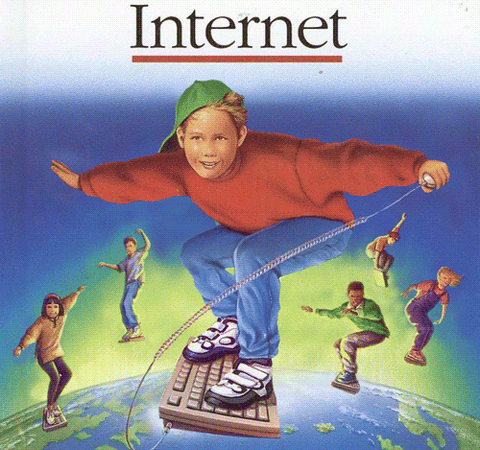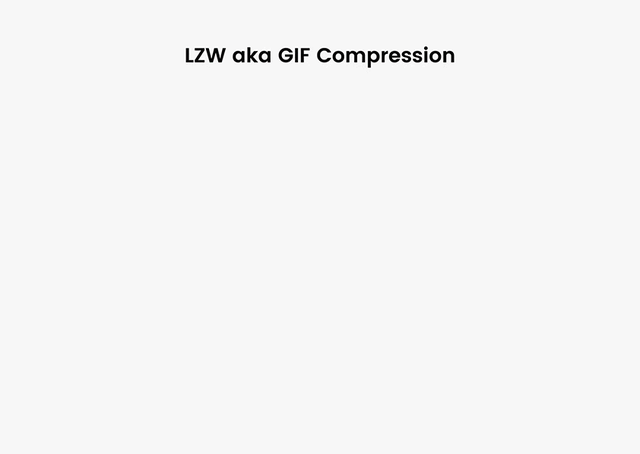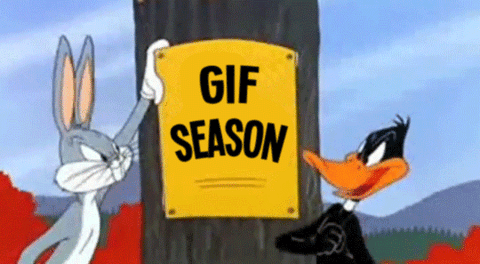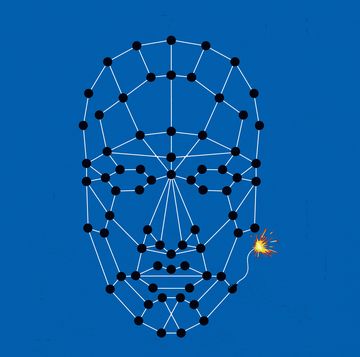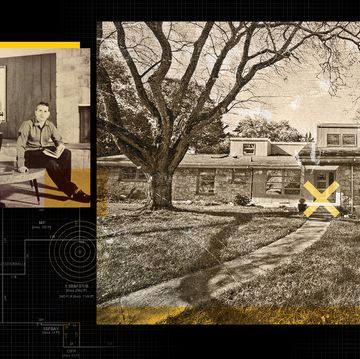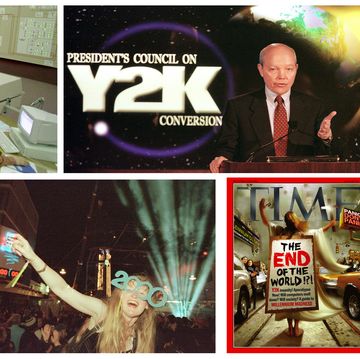Editor’s Note: This story originally published in March 2018. We’re republishing the piece following news that Stephen Wilhite, one of the lead creators of the GIF, died earlier this month after contracting COVID-19. Wilhite worked on the GIF, short for graphics interchange format, while working for the online service provider CompuServe in the 1980s.
November 5, 1999, was Burn All GIFs Day. Had you visited its homepage that Friday, you would have seen the movement’s game plan laid out as plainly as its name: “On Burn All GIFs Day, all GIF users will gather at Unisys and burn all their GIF files.” This, alongside a selection of pointedly anti-GIF imagery—all proudly PNG files.
Despite the obvious joke of setting files on fire, acknowledged with a winking plea to “extinguish all GIFs before leaving the vicinity,” the anger was real and the mission was earnest: to free the web from the scourge of the GIF once and for all.
Already more than a decade old and with roots reaching to June 15th, 1987—half a decade before the World Wide Web itself—the GIF was showing its age. It offered support for a paltry 256 colors. Its animation capabilities were easily rivaled by a flipbook. It was markedly inferior to virtually every file format that had followed it. On top of that, there were the threats of litigation from parent companies and patent-holders which had been looming over GIF users for five long years before the fiery call to action. By Burn All GIFs Day, the GIF was wobbling on the precipice of destruction. Those who knew enough to care deeply about file formats and the future of the web were marching on the gates, armed with PNGs of torches and pitchforks.
And yet, somehow, here we are. Seventeen years later, the GIF not only isn’t dead. It rules the web.
Earlier this year, Twitter introduced a built-in search engine that offers split-second access to a library of thousands upon thousands of GIFs. Giphy, the company that curates that library, raised $55 million dollars in its latest round of funding, bringing its total value to some $300 million. A year before that, Imgur—until very recently the de facto image hosting service for the media mammoth Reddit and a $200 million company in its own right—rolled out GIFV, its own attempt to modernize the nearly 30-year-old file format.
The GIF as an art form—a short and silent loop—has never been more popular than it is right now. Yet the GIF as a filetype, the way we store the library of ones and zeros that computers translate into animation, is quietly embattled. Behind the scenes, a war to exterminate it has been raging for years, and it never really ended. All these years after Burn All GIFs Day, the GIF remains both deeply flawed and yet strangely irreplaceable. Whether this latest frenzy of GIF popularity enshrines it forever or kills it for good, you can be damn sure we’ll never see anything quite like it again.
Ask anyone what a GIF is and two things will happen. First, you’ll either agree or fight about the pronunciation (hard G, no matter what anyone says). Then they’ll say something about animation. Dancing bananas, technicolor spinning text. A GIF is something bite-sized and looping, they’ll say. Modern-day silent movies that automatically repeat. That barely scratches the surface of the story.
When the GIF was first born in 1987, animation wasn’t even in the picture—neither was the World Wide Web. The team of programmers at CompuServe led by Steve Wilhite, the well-known father of the file format, built the GIF around something completely separate from the animation party-trick it’s known for today. The cornerstone was something called Lempel–Ziv–Welch (LZW) compression.
Unless you’re a student of algorithmic data compression, the unwieldy name is probably unfamiliar. Its quiet effect on the digital world is undeniable. LZW is a lossless compression algorithm, a series of instructions that allows the very bits and bytes of images and files to fit into ever smaller packages (that’s the compression part) without slicing off any data in the process (that’s the lossless part). It’s like packing all your clothes into a smaller suitcase by cramming them in tighter, without taking anything out. LZW wasn’t the first algorithm of its kind. First detailed in the June 1984 issue of IEEE Computer in an easy-to-understand article titled “A Technique for High-Performance Data Compression,” LZW was based on the LZ78 algorithm that came before it and offered a big improvement over its predecessor. LZW quickly went to work inside things like early ZIP file compressors and, yes, the GIF.
This compression gave the GIF capabilities that may as well have been superpowers at the time. Previous innovations in image compression, like “run-length encoding,” would shrink files by just simplifying instances of repeated data. A string of pixels in an image that was originally stored as “one black pixel, one black pixel, one black pixel” could become the simpler and smaller list “three black pixels.” Run-length encoding was fine for simple black and white pictures, but it would gulp at the prospect of even a few dozen colors and downright choke when they started mixing.
LZW’s more complex approach allowed computers to collapse strings of data that were far more complicated than the same thing over and over again, as long as these strings contained some sort of repeating pattern. Essentially, it let computers invent a whole new phrase like “blite” pixel for combinations like “a blue pixel, a white pixel,” but also combo-phrases like “bliteple” pixel for “blite pixel, purple pixel” and on and on, cramming more and more information into a single new word. This approach made the GIF uniquely talented at fitting photorealistic color images with their interwoven colors into small and practical packages.
These tricks came at just the right time. As modems, graphics cards, and CD-ROMs flourished in the pre-web home-computing boom, the GIF became an instant standard for photorealistic images. The idea of a static GIF might seem heretical today, but in 1992 that was pretty much the only GIF around, and it was glorious. Look no further than “GIFs Galore,” a CD-ROM that was chock full of pictures just because it was possible. By the time the World Wide Web was spinning up in the mid-90s, the GIF was paved right into the asphalt of the information superhighway. In 1993, when the revolutionary Mosaic browser launched, it supported two image formats: the proven GIF and the nascent JPEG. The first photo that showed up on the web? A GIF.
Two decades later, you rarely see the GIF used for still images, because it’s been effectively clobbered out of existence by newer and better JPEGs and PNGs. But the animated GIF still stands unrivaled. Unrivaled and all over the dang place. It’s ironic, because if static GIF was a roaring success story—the picture of proficiency—then the animated GIF is its bizarro twin. It lives on despite the internet’s heartfelt attempts to murder it, and it is awful at the only thing anyone ever uses it for.
Here’s the dirty little secret about the modern-day animated GIF: Behind that looping animation on the screen, there is often no GIF at all, no one file packed up with a “.GIF” extension like a bow on top.
Those reaction GIFs on Twitter? Not actually GIFs. The loops you’ll find plastered all over Reddit (especially the ones that look suspiciouslygood)? Most of them aren’t GIFs either. Some of the GIFs on this very page are imposters. They are video files—not unlike what you’d find on YouTube—but ones that are sneakily instructed to act like animated GIFs.
A GIF will automatically play and loop in silence because of its inherent makeup; it’s a feature built into the file. These video file imposters, however, are different. They require code embedded in the page that surrounds them—code that orders them to adopt some quaint characteristics: play on mute, loop forever, don’t display any sort of control bar or, heaven forbid, a pause button. These are videos with their hands tied behind their backs so they appear to be something simpler than they really are.
Semantics? It’s anything but. Once you start teasing out the difference between a real GIF and a fake, it’s easy to see why these more complex imposters are often preferable to the genuine item.
An animated GIF is a series of sequential frames played in order with a delay between them to create the illusion of movement. Those frames are all contained within a single GIF file that holds all the still images along with instructions on how fast to go through them. It’s a little digital flipbook.
A GIF is not just a snippet of muted video on repeat. Digital video is vastly more intricate. Unlike GIFs, video files don’t actually contain every frame of animation you see, at least not in the traditional sense. Some frames in a given video file, called I-frames, will be stored as entire full-fledged pictures, but in between these are B- and P-frames which just contain instructions on how to transform one frame into the next by changing a few pixels here and a chunk of colors there, while leaving everything else the same.
Remember what we were saying about LZW—the way a still image GIF saves instructions instead of every single pixel? Digital video takes what the GIF does in space, but does it in space and time. Considering your average video can have as many as 60 frames per second, this can save a truly bonkers number of bytes. GIFs have to sacrifice quality to save space, but videos can look much better while also being much smaller.
Take, for example, this short video of a nice dog being a very good boy:
As a GIF, it takes up more than 60 MB because every single frame needs to be stored as a complete image. As an .mp4 video file, this same clip is less than 3 MB because the instructions required to transform one frame of a good dog into the next frame of a good dog are miniscule. That difference in file size is the difference between streaming a few hours of music versus downloading a single song.
It only takes one giant GIF like this to bog down a web page and make it load like molasses. On mobile, where every MB of data is precious, a single huge GIF can also eat up a noticeable chunk of your monthly allotment. On top of that, a GIF doesn’t have a play button you can opt out of pushing; it just immediately barges through the door and starts loading. And poorly too! Modern day videos can stream, loading in their front bits first so you can watch seamless footage while the rest of the clip is still downloading. Dumb-as-a-doornail GIFs, meanwhile, can do nothing but herk and jerk their way through that whole first loop. For all their whimsy, true animated GIFs are a menace of the modern mobile web.
But all of these horrible downsides are balanced out by one huge advantage: Compared to video, the GIF is ridiculously easy to use. Using a GIF requires no plugins, no codecs, no tinkering with embed code. It works everywhere, simply and immediately. Just copy the link or download the file and you’re good to go.
So why isn’t there a format that puts these two pieces together? Why hasn’t anyone combined the smarts of a video and the dead simplicity of the GIF?
They tried. The best chance came and went 20 years ago.
“We all felt a bit betrayed.”
In late 1994, the GIF was the internet’s aging but comfortable standard. But by early 1995, a coalition had organized to destroy it. What happened?
Michael C. Battilana, a developer who would write one of the best and most in-depth accounts of the controversy at the time, was there in the thick of it when everything changed. “After all the work and success, it turned out that suddenly there was a patent. No one in the community at large had known.”
This was the GIF’s original sin, an oversight that started a war in 1994 when CompuServe and Unisys made a surprise announcement: Unisys would license LZW to CompuServe for use in the GIF, in exchange for a nominal fee. Not only that, but Unisys was looking to make similar license agreements with everyone who traded in the files. The tech-savvy saw the writing on the wall. After years of free use—formative years, during which the World Wide Web itself was born—making GIFs was about to cost money.
The specter of this so-called “GIF Tax” sparked a sudden wave of outrage that included the theatrical mass deletion of GIFs from BBSes and websites. Pat Clawson, President and CEO of one TeleGrafix Communications Inc, wasted no time in invoking World War II in an open letter just days after the announcement:
The announcement by CompuServe and Unisys that users of the GIF image format must register by January 10 and pay a royalty or face lawsuits for their past usage, is the online communications community’s equivalent of the sneak attack at Pearl Harbor. The announcement of the CompuServe-Unisys GIF Tax on December 29, during the lull between Christmas and New Year’s Day, was clearly timed to cause maximum damage while an unsuspecting public celebrated the holidays.
Contrary to the widespread belief that Unisys wanted to tax GIFs themselves, charging everyday nerds and webmasters a fee to use them, the legal action was focused on software that made GIFs. The distilleries, not the booze. Still, this was a cold comfort to developers making and selling image-editing software and the first step to GIF eradication was under way: the frantic race for an alternative.
Outrage coalesced into an actionable plan on the usenet newsgroup “comp.graphics,” within a chain called “Thoughts on a GIF-replacement file format.” Here, some of the web’s most prominent engineers—including some of those instrumental in the earlier creation of the JPEG—debated a series of GIF alternatives. The end result was a new lossless file type that could serve many of the same purposes of the GIF while improving on its creaky tech: a little thing called the PNG.
Just a year later in 1996, the group released version 1.0 of the Portable Network Graphics (shortened from the proposed PING for “PING Is Not GIF”) to bury the GIF. The PNG offered support for thousands of colors as opposed to a GIF’s hard limit of 256. It had better options for transparency. Best of all, it was completely open-source and patent-free, freeing users from any looming lawsuit dread. It was better than the GIF in almost every way.
Almost. The PNG couldn’t animate, but this detail that would turn out to be the PNG’s Achilles’ heel was a decision, not a flaw. The designers of the PNG saw the GIF’s double-duty not as a superpower but as bad design. “They were very radical about not wanting animation,” Battilana recalls. It was a pretty defensible position. What sort of image format reserves the right to spontaneously animate? What sort of video format does its job so inefficiency? A bad one. So PNG would forever and always cover only still images, its creators decreed, while animation would be the domain of some other, better file type yet to come. Besides, the logic went, this whole animation thing was just a gimmick anyway.
If you’ve spent any time on the internet lately, then you know how wildly misguided that thinking proved to be. What those bigwig web engineers missed was just how useful the animation gimmick could be. “GIF was never meant as a video format, but for pages and browsers that never supported any video format other than Flash, it was the only alternative,” Battilana says. “Even browsers today don’t have a good alternative to GIF unless you want a very sophisticated and still patent-covered video like MPEG-2 or MPEG-4.” The GIF just works.
PNG picked up speed in the years that followed, helping to drive the single-image GIFs that dominated the early web to extinction. But those gimmicky animated GIFs kept the format alive, even as PNG backers were twisting the knife. Even by the time of Burn All GIFs Day in 1999—another peak of anti-GIF sentiment spurred by Unisys’s renewed attempts to clarify (and/or make money off) its LZW patent that would expire in only a few years—there was no viable alternative that could do the one simple thing the animated GIF could do. It wasn’t until 2001 that the PNG group’s animated GIF-killer-that-couldn’t, MNG, emerged to find a web that had finally resigned itself to the GIF.
Then in 2004, the battle was over. That summer the Unisys patent on LZW expired worldwide. “It was an explosion,” Battilana remembers. “Everyone could use GIF again.” After nearly a decade of attacks by a cabal of the internet’s most influential users, the animated GIF stood tall, timeworn yet somehow on top.
If the world couldn’t replace the GIF back then, with that unity of purpose, how could it ever happen now?
You can go and visit the moment when the GIF finally began to crack. It’s frozen in amber deep in the World Wide Web Consortium’s archives, surrounded by nearly 200,000 words of incomprehensible technical jargon. This colossal document from 2008 is the first public working draft of HTML 5, the dictionary that defines the building blocks that make up the modern web. The item of interest is 3.14.7. “The video element.” Thanks to this section, there was finally a standard for how moving pictures should work on the web.
In the bad old days, web video was dominated by things like Adobe Flash and RealPlayer, solutions that required third-party plugins or other software you’d have to opt into, download, and update. It was a complicated solution layered on top of a web that was built without video in mind. The situation was so annoying that the GIF’s ubiquity and simplicity—really its only two talents—were enough to keep it on top. But when HTML 5 made video a first-class citizen, with easy ways to deal with the myriad differences between browsers and control exactly how video is displayed, those twin advantages began to fade. As HTML 5 spread, the GIF suddenly saw its first serious competition in nearly a decade.
The first whiffs of this sea change came in early 2014 when Gfycat started converting its GIFs into video files. But the most refined and most compelling change came later that year, in the form of Imgur’s GIFV.
*The above is ironically hosted on Gfycat because recent changes to the GIFV’s guts mean it doesn’t play nice with our site. More on that in a second.
At its heart, the GIFV is just a standard implementation of HTML 5 video. Click on a link to a GIFV and you’ll be taken to a page that looks like it holds a GIF, and nothing else. The clip plays automatically. It loops. It has no scrub bar, no pause button, no visible controls, no sound. It’s a perfect example of the ever more common imposter-GIF, a video file dumbed down to look like its older counterpart. The cherry on top of this particular imposter, from which it derives its name, is the file extension “.GIFV” that sits at the end of the address when you see it in your browser. It’s a friendly and familiar little touch that makes it feel just like the files you are used to.
But GIFV isn’t a GIF, or a video, or even some sort of filetype that blends the two. It’s an illusion. As Imgur founder and CEO Alan Schaaf explained to me over the phone:
The GIFV isn’t actually a new format; we didn’t create a new filetype. It is just a smart wrapper, a smart file extension that signals what you are going to get and makes videos work exactly like GIFs in as many places as possible. There are default controls on a bunch of different browsers, but the GIFV accounts for that so wherever you put a GIFV, it should act like a normal GIF.
There is a side effect of this otherwise clever trick: A GIFV is not a thing so much as it is a place, a place you need an internet connection to reach. You can download and store pieces of a GIFV—a .webm or .mp4 video file, the giant and unwieldy GIF itself—but the real GIFV necessarily lives online, grafted to the page where it’s displayed, reliant upon Imgur to continue hosting the file and not modify the GIFV’s inner workings in a way that screws everything up. You can email or text it as you would a link to any other site, but you can’t pull it down and move it around like you would a good ol’ GIF.
Imgur’s GIFV isn’t the only example of this kind of tradeoff. Plenty of social media networks that support the GIF do it in a similar way. When you upload a GIF to Twitter, it doesn’t just get posted as-is. In the process it is irrevocably transformed into an .mp4 video file. When you post a GIF to Facebook, it’s transformed into some cyborg nightmare of video and code that’s so complex I can’t even figure out what it is, much less download it and put it somewhere else.
The web of 2016 is not the web of 2006. It’s chock full of these walled gardens, these “platforms.” And while each might still understand what a GIF is, these generally don’t “support” GIFs so much as they suck them in and never let them escape. Think about it this way: If GIFs are like framed pictures you can take down and move to your new house, these GIF-like videos are murals painted right onto the wall. The same general form, but with a big chunk of missing function. GIFs are for sharing, and you can’t take a Twitter GIF with you.
The perfect solution? A way to seamlessly move GIFs to and from the various sites and services that half-way support them today. Something that lets you bookmark a Twitter .mp4 and use it in a text message later. Something that can keep a library of your favorites at the ready for instant use anywhere, regardless of the filetype. In a word: Giphy.
As of February, the self-styled Netflix of GIFs has worked up a valuation of some $300 million based in part on this dream. Giphy has all the GIFs, and Giphy is everywhere. The “GIF” button on Twitter? Powered (in part) by Giphy. Facebook? Giphy is there. Mobile phone keyboards? Check. Text messaging apps? Sure thing! Email? Of course. Tinder? Yes. Slack? Duhhhh.
With these dozens of tendrils, Giphy is in a unique position to solve the twin problems of GIF-like videos: the inability to move a GIF from one app or social network to another, and the inability to save it as anything more than a link to a website. If a GIF is on Giphy, you can use it anywhere Giphy is (just about anywhere). Create an account and you can save your favorites to a personal library. When it comes time to get down to business, Giphy will handle all the pesky logistics of translating the actual GIF into whatever weird video thing Facebook or Twitter wants to use instead.
But it’s not without its downsides, starting with the thorny questions of ownership. Embracing Giphy at the expense of GIF files is like giving up your collection of DVDs for a subscription to Netflix. You’re ceding control to get convenience and selection. As Giphy subsumes the GIF, it is replacing an agnostic file type that has grown into an artistic medium with a branded canon—and all that entails.
Consider the Terms of Service, for example. Giphy bans the obvious, like pornography (a very popular subject for GIFs!), but also bans other, vaguer things like content “you know is false, misleading, untruthful or inaccurate,” whatever that means. Giphy is DMCA compliant. Are viral sports GIFs copyright infringement and subject to takedown? Or clips of TV shows and movies which make up the vast majority of popular GIFs? Filetypes don’t have to care about this crap because you can’t sue a GIF. Services do.
It’s a question Twitter has already grappled with, deciding to err on the side of censorship and suspend various sports blogs for posting GIFs that the NFL felt like it owned. And while we all chuckled at the International Olympic Committee’s absurd attempt to ban GIFs of the 2016 Olympics, Twitter was quietly and obligingly honoring DMCA takedown requests. Elsewhere on the internet, YouTube’s Content ID system automatically removes videos at the slightest notion of an infraction. We are guilty until proven innocent, and cases of fair use are fuzzy at best.
Giphy, as a company that has money and employs people, would be reckless not to behave the same way. Besides, you don’t take millions of dollars in venture capital just to get into legal battles—especially when your ideal future is advertising. Take this hypothetical that Giphy CEO Alex Chung spun to CNBC last year:
Imagine when someone is hungry, they search for McDonald’s Big Mac GIFs and then share it out. That is the holy grail of advertising. Your marketing no longer becomes marketing, but becomes part of the culture and part of the conversation in a very natural way. There’s a lot of potential there.
Not that any of this is nefarious. It just comes with the territory of being a company, just like Unisys’s quest to get something out of the algorithm it owned the patent for. But what Giphy is creating is not a filetype, but a service. There are no patents to expire, no underlying tech that will someday be set free.
The good news is that Giphy still maintains its ties to that old, free tech. If you dig into Giphy’s online archives, you’ll find embeddable HTML 5 videos, sure. But you’ll also still find the GIF file. Why? As Nick Hasty, Director of Engineering at Giphy, explained to me over email:
GIPHY believes in the experiential magic of viewing an infinitely looping series of images. While we have encoded all our GIFs into the most popular video formats and make those available on our site, the fact that GIFs play everywhere, can be copied and pasted, dragged and dropped, and don’t force you to open a different interface or app for viewing, make them a better choice for what we’re doing than any alternative formats.
He’s right, the GIF’s ubiquity makes it supremely useful as a lingua franca between dozens of apps and platforms. It is the original you can photocopy. But if (or once) Giphy becomes ubiquitous or close enough, that last use for the GIF falls away. Someday Giphy might be able to replace the GIF, not with some alternative filetype or even some GIFV-esque melding of GIF and video, but with itself.
That future is already here on apps like Tinder, where Giphy is effectively the only option for anything resembling a GIF. Twitter and Facebook have both taken half-steps in that direction. It’s not hard to imagine a future in which the most popular sites in the world phase out direct GIF uploads, leaving Giphy as the only option.
And what if Giphy itself no longer accepts its namesake GIF? No more tweaking frames in Photoshop and uploading a finished product. Instead, everyone will make “GIFs” by clicking Giphy’s Create button, slicing up YouTube videos, and sending their creations off to the cloud. These loops will load quicker and look more beautiful than any true GIF ever could, using up the merest whisper of your data cap—so long as Giphy’s servers are up and no takedowns have been filed.
It would be a fitting end to the GIF. Its decades-long resilience is rooted in simplicity and being in the right place at the right time. Giphy is the opposite, amorphous and cutting-edge. The GIF is a dandelion, relentlessly cropping up along all the other flowers in the garden year after year. Giphy is a coat of asphalt.
“I can’t watch anything without looking for potential GIFs in it anymore.”
It’s understandable. After you’ve made a couple thousand silent video loops, you start to see them everywhere. It happens to me, but Jason Walter—known online by his handle EditingAndLayout—is on another level. With his own subreddit and years of loops under his belt, his work is superlative GIFsmanship. The style he’s known for is modest but peerless. “There are all these graphic designer people making GIFs with like movie-quality special effects. I don’t know how to do any of that,” he says. He likes to use clips from old movies, taking clips of compressed digital video, and translating them back to something just slightly more like a filmstrip. His favorite is from 1953’s Roman Holiday. “Audrey Hepburn, just her laughing. I just love it. I don’t know why.”
The reaction GIF, this sort of pop culture clip often accompanied by subtitles, is arguably the art form’s most pedestrian genre, but Walter is inarguably one of its best practitioners. “When I started making GIFs,” he recalls, “hardly anyone was making them in Photoshop. You had all those ones where the clip shows some characters saying about two words, but then there’s like two sentences down at the bottom. Standard Tumblr stuff.”
Walter’s GIFs are anything but. You’ve probably seen them; they get around. They’re silky smooth and pop with color. Most importantly, the subtitles match the scene (when they’re not about something else all together).
His work, quality obsessed as it is, makes him a prime candidate for using video-GIFs. And some of his longer, more ambitious GIFs would be unwieldy to watch without video compression to help. But his heart remains with the old school GIF, not in spite of its limitations but because of them.
“Imgur’s limit was 2 MB back when I really started. You couldn’t even upload a file bigger than that. You just had to figure out how to make it smaller.”
There are plenty of ways, from cutting out or freezing frames, messing with transparency, cutting the resolution, choosing a smaller color palette, or mixing a few different forms of visible and lossy compression techniques. All of these options come at the cost of quality, but when finessed by an expert, you’d be hard-pressed to notice.
These tricks aren’t mandatory like they used to be. Imgur will take GIFs upwards of 100 MB and transform them into a video, Gfycat much the same. Some holdouts still cap uploads. Twitter held fast at 5 MB for a while before upping the limit to a roomier 15 MB, and so the rift between the looping art and its original digital medium continues to grow. “GIF-to-video kind of killed that aspect of optimizing and making good, smaller GIFs. I still kind of miss that. I still try to make them under 5 MB sometimes.”
Walter is not opposed to video-GIF alternatives, but he is wary of where the trend leads. “Anything that can get the size of the format down is a good thing. I have data cap at my house. The are limits on phone data plans. But the tech encourages people who make GIFs to be lazy, in a way. They’re creating these GIFs and keeping them at 1920 by 1080 with tons of colors. Like at 50 MB. It’s not that hard to do that. It’s really just a clip of video without sound at that point.”
In the end, that concern—the mere awareness of what’s happening—serves a purpose on its own. The GIF’s history echoes through its future. In the time since our chat, Walter announced his “retirement,” but the subreddit he founded, R/HighQualityGIFs, lives on as a bastion for both carefully crafted GIFs and GIF-like videos. It’s home to some 150,000 subscribers and all sorts of information from experts on how to make GIFs in Photoshop, or in Adobe After Effects, or how to make them loop perfectly. It is only one of many pockets of the internet devoted not only to the art form, but to the respect and preservation of its originating medium, equal parts school and museum.
“That puzzle of trying to make a GIF look good and still get the size in under the line, that is like an art form to me.”
So long as there’s at least one true GIFsmith left, the GIF can never truly die.




